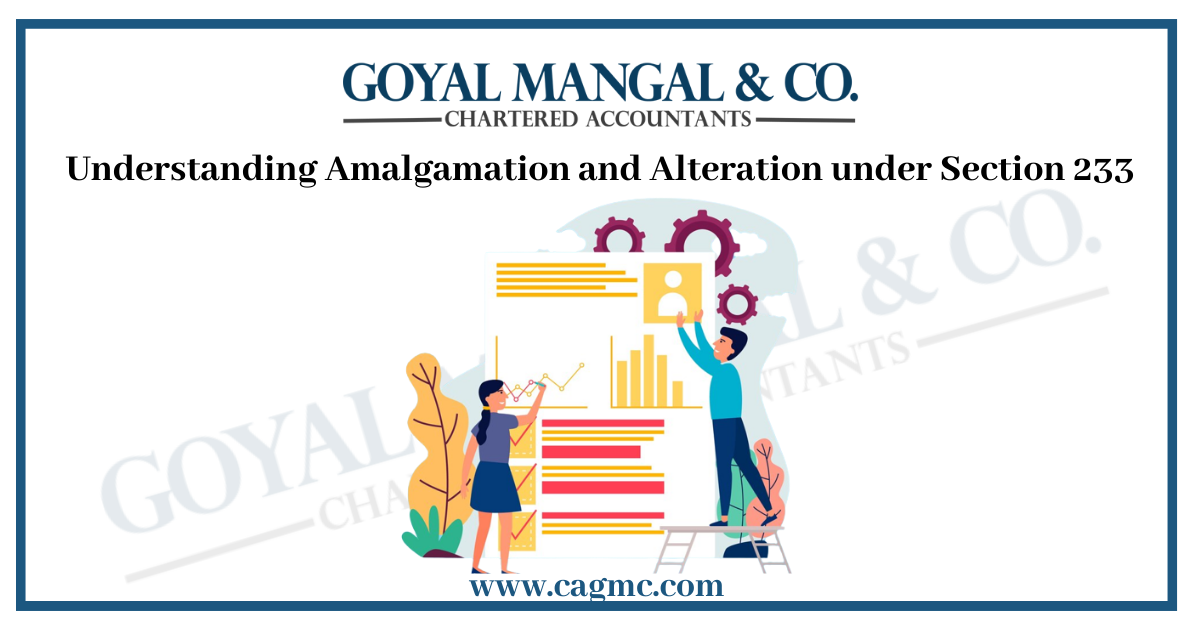
Section 233 of the Companies Act, 2013 is a provision that plays a significant role in corporate restructuring in India. It addresses the merger of companies and allows for certain alterations to be made during the process. However, understanding Amalgamation and Alteration Section 233 permits such alterations is a matter of importance for businesses and stakeholders. In this blog, we’ll explore the key aspects of Section 233 and its implications on amalgamation alterations.
Table of Contents
Overview
When business and law come together, they often mention interesting questions. For example, is it legal to amend a scheme of amalgamation and alteration filed under Section 233 of the Companies Act, 2013? The topic has been getting more attention lately because of a case about merging that was brought before the Regional Director. The question at hand is about whether it is possible to make the necessary changes after the amalgamation scheme has been submitted.
Case Instance
In this instance, the Registrar of Companies (ROC) submitted their observation on the Scheme of Amalgamation through their ROC Report. After careful consideration, the client was requested to make appropriate modifications to the scheme and obtain approval without withdrawing it. Consequently, we complied with our client’s requirements. Upon submitting the application for alteration, the Regional Director instructed the Registrar to provide a revised Report. In this revised report, the Registrar of Companies (ROC) stated that as per Section 233 of the Companies Act, 2013, the matter needs to be forwarded to NCLT and ROC stated that it’s not allowed to make any changes, or modifications to the amalgamation scheme.
Above case instance Finding
Considering the, our research has extensively examined the observation put out by the ROC. Our findings indicate that neither Section 230 and 232 nor Section 233 of the Companies Act, 2013 address the matter of modification or alteration in the Scheme of Amalgamation After doing more research, it was found that the National Company Law Tribunal (NCLT) or the Regional Director (RD) has the power to decide whether to allow the change or amendment in the plan of amalgamation.
There are two things that determine this decision: whether the formal process was followed correctly and whether the plan is seen as good for everyone. If the company followed the right legal steps and the suggested changes were seen as good for everyone, they were usually okay with by the right authorities.
Case Laws
- Case of Selina Exim Pvt Ltd. v. LNIND 2014 DEL 3999: Following the submission of the second motion application, the Board of Directors of the petitioner business made the decision to implement modifications to the Scheme of Amalgamation between Selina Exim Private Limited and Ecodel Projects Private Limited. The revised scheme of merger was unanimously approved by the board of directors of the transferor firm during their board meeting held on 28 January 2014. Subsequently, the petitioner corporations applied seeking approval for the new scheme.
- Case of VINAY SECURITIES PVT. LTD. AND ORS. V. SHAKTI IRRIGATION INDIA LTD: During the presentation of the new scheme for NCLT sanction, the petitioner firms provided consent affidavits from the preferred shareholders of the respective companies to support the revised scheme. The present communication pertains to Interlocutory Application No. 413 of 2019, filed before the National Company Law Tribunal in Indore.
- Case of BORGOSESIA RINGS PVT. LTD. V. TEXSPIN BEARINGS LTD: The petitioner companies have submitted an interlocutory application to the National Company Law Tribunal (NCLT) to request permission for making specific adjustments to the scheme previously filed with the relevant body. These amendments are in response to objections raised by various statutory authorities. The National Company Law Tribunal (NCLT), upon determining that the proposed revision does not harm the public’s interests, granted the application, and instructed the petitioner businesses to publish a new notice to the relevant statutory bodies, along with the modified scheme. The present communication pertains to Interlocutory Application No. 495 of 2019 filed before the National Company Law Tribunal, Ahmedabad.
- Case of EUROPLUS FINANCIAL SERVICES LIMITED AND ORS. V. ALANKIT TECHNOLOGIES LIMITED: The issue highlighted by the regional director in their report pertains to clause 16(d) of the proposed plan, specifically addressing the post-amalgamation Authorized share capital. It was noted that the total authorized share capital after the amalgamation would amount to Rs. 6,00,00,000, consisting of 60,00,000 equity shares with a face value of Rs. 10/- each. However, an amount of Rs. 8,00,00,000, divided into 80,00,000 equity shares with a face value of Rs. 10/- each, was specified instead. Subsequently, considering the raised observation, the relevant scheme underwent revision and dissemination, and subsequently got approval as no objections were raised. The case under consideration is Company Petition No. CAA-107(PB)/2019, which is now being heard before the National Company Law Tribunal in New Delhi.
Final Words
In conclusion, the Companies Act, 2013, does not explicitly allow changes to an amalgamation plan under Section 233. However, there are two things that determine this decision: whether the formal process was followed correctly and whether the plan is seen as good for everyone. If the company followed the right legal steps and the suggested changes were seen as good for everyone, they were usually okay with by the right authorities. Hence, the issue is still open because the result mostly relies on the unique circumstances of each case and the legal interpretation given by the appropriate authorities.


